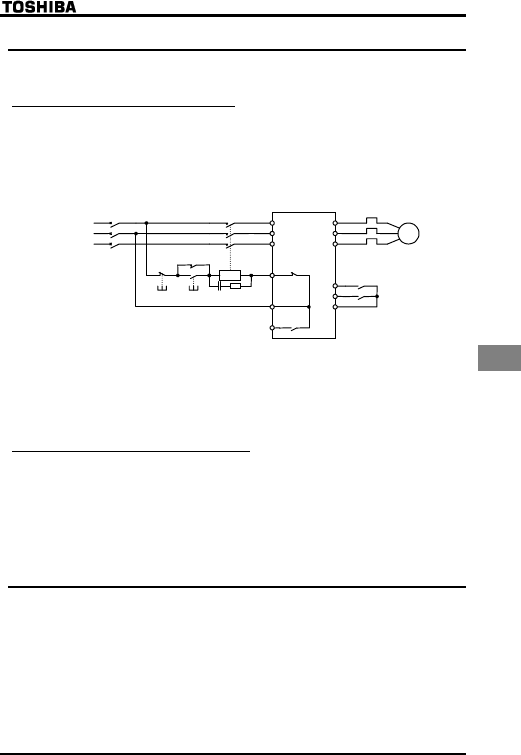
E6581090
J-3
10
10.2 Installation of a magnetic contactor
If using the inverter without installing a magnetic contactor (MC) in the primary circuit, use an MCCB
(with a power cutoff device) to open the primary circuit when the inverter protective circuit is activated.
■Magnetic contactor in the primary circuit
A magnetic contactor, if installed in the power supply circuit of the inverter, cuts off the power
supply to the circuit and prevents the inverter from restarting, in the event of a power failure, a trip
of the overload relay (thermal relay) or the activation of the inverter protective circuit.
In addition, if the FL contact of the failure detection relay in the VF-nC1 is connected to the
operation circuit of the magnetic contactor on the primary side, the magnetic contactor (MC) will be
tripped when the inverter protective circuit is activated.
Notes on wiring
• When frequently switching between start and stop, do not use the magnetic contactor on the
primary side as an on-off switch for the inverter. Instead, stop and start the inverter by using
terminals F and CC (forward run) or R and CC (reverse run).
• Be sure to attach a surge killer to the exciting coil of the magnetic contactor (MC).
■Magnetic contactor in the secondary circuit
A magnetic contactor may be installed on the secondary side to switch controlled motors or supply
commercial power to the load when the inverter is out of operation.
Notes on wiring
• Be sure to interlock the magnetic contactor on the secondary side with the power supply to
prevent commercial power from being applied to the inverter output terminals.
• When installing a magnetic contactor (MC) between the inverter and the motor, avoid turning the
magnetic contactor on or off during operation. Turning the magnetic contactor on or off during
operation causes a current to rush into the inverter which could lead to malfunction.
10.3 Installation of an overload relay
1) The VF-nC1 inverter has an electronic-thermal overload protective function. In the following
cases, however, the activation level of the electronic thermal protection unit must be adjusted
and an overload relay suitable for the motor installed between the inverter and the motor.
• When using a motor with a current rating different to that of the corresponding Toshiba
general-purpose motor
• When operating a single motor with an output smaller than that of the applicable standard
motor or more than one motor simultaneously
2) When using the VF-nC1 inverter to operate a constant-torque motor, such as the Toshiba VF
motor, adjust the protection characteristic of the electronic thermal protection unit to the VF
motor use.
3) It is recommended to use a motor with a thermal relay embedded in the motor coil to give
sufficient protection to the motor, especially when it runs in a low-speed range.
Example of connection of a magnetic contactor in the primary circuit
MC
IM
MC
MC
MCCB
Sur
g
e kille
r
F
R
CC
Forward run
Reverse run
U/T1
V/T2
W/T3
R/L1
S/L2
T/L3
FLB
FLC
FLA
VF-nC1
Powe
r
suppl
y
Thermal rela
y
Moto
r


















